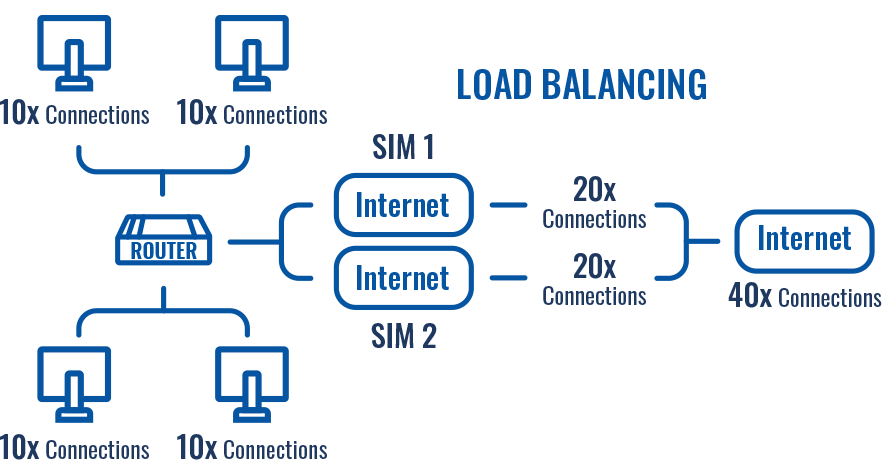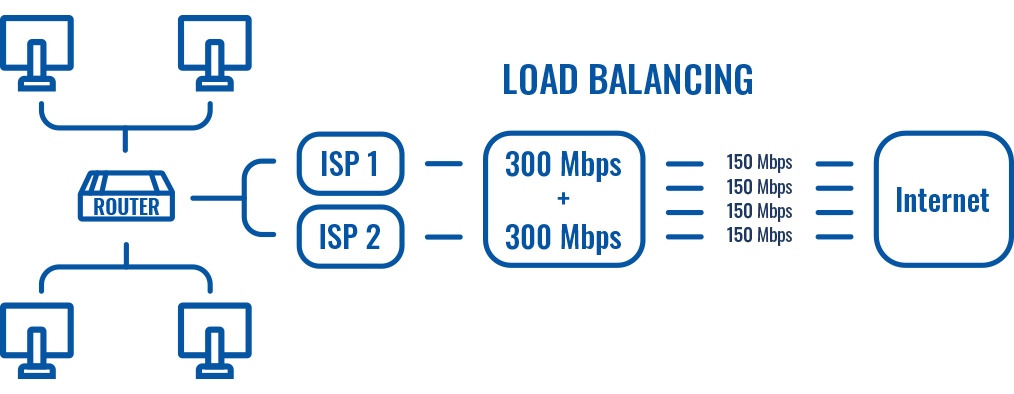Difference between revisions of "LTE Bonding vs Load Balancing"
m (→Bonding) |
|||
| Line 4: | Line 4: | ||
<b>Load balancing</b> is used to efficiently distribute the resources of multiple Internet service providers (ISPs) on one device among many clients and connections. <b>Bonding</b> is used to utilize the resources of multiple ISPs in order to achieve higher speeds for a single connection. Therefore, load balancing is usually used to provide better service to an entire network by distributing existing resources (such as a large WiFi network), while bonding is used where having the max speed for a single connection is required (such as video streaming or large file download). | <b>Load balancing</b> is used to efficiently distribute the resources of multiple Internet service providers (ISPs) on one device among many clients and connections. <b>Bonding</b> is used to utilize the resources of multiple ISPs in order to achieve higher speeds for a single connection. Therefore, load balancing is usually used to provide better service to an entire network by distributing existing resources (such as a large WiFi network), while bonding is used where having the max speed for a single connection is required (such as video streaming or large file download). | ||
---- | ---- | ||
| − | This article discusses the differences between bonding and load balancing processes in LTE (<u>specifically</u>) connections for devices that have multiple LTE modules. Currently, only these Teltonika-Networks devices support dual-LTE: | + | This article discusses the '''differences between bonding and load balancing processes in LTE''' (<u>specifically</u>) connections for devices that have multiple LTE modules. Currently, only these Teltonika-Networks devices support dual-LTE: |
<ul> | <ul> | ||
Latest revision as of 08:35, 15 April 2021
Main Page > FAQ > Other Topics > LTE Bonding vs Load BalancingSummary
Load balancing is used to efficiently distribute the resources of multiple Internet service providers (ISPs) on one device among many clients and connections. Bonding is used to utilize the resources of multiple ISPs in order to achieve higher speeds for a single connection. Therefore, load balancing is usually used to provide better service to an entire network by distributing existing resources (such as a large WiFi network), while bonding is used where having the max speed for a single connection is required (such as video streaming or large file download).
This article discusses the differences between bonding and load balancing processes in LTE (specifically) connections for devices that have multiple LTE modules. Currently, only these Teltonika-Networks devices support dual-LTE:
If you wish to learn how to configure load balancing on Teltonika-Networks devices, please watch this video.
Note: Teltonika-Networks devices do not support bonding.
Load balancing
Load balancing is way of distributing traffic over multiple connections. It does not bond the connections together, but distributes the available resources among clients and connections.
For example, in a network with 4 clients that have established 10 connections to the Internet each, 50/50 ratio load balancing can distribute this traffic equally over two different network interfaces using different ISPs. (Other ratios can be applied as well.)
Bonding
Bonding is the process of aggregating multiple individual connections into a single connection. In other words, bonding can combine the resources of multiple ISPs in order to increase the speed of a single connection.
It works by establishing multiple connections over different ISPs to a VPN server. Data is sent and received over all connections and added up at the server. Thus, bonding can provide much faster data rates for a single connection.
For example, let's assume that a device behind a router with two SIM cards wants to establish a connection with a host on the Internet. When the router is using bonding, two separate connections to a VPN server are established over each SIM card interface. Then data from the end device to the host can be transferred via the server using both connections at the same time.
Speed comparison
Both bonding and load balancing data speeds will depend on a device's software and hardware capabilities.
For example, when using load balancing on a RUTX12 you may expect SIM1 plus SIM2 speed minus about 15 %*:
*15 % is a good factor for managing expectations. The actual speed value may be both higher or lower, depending on the environment of operation.
If compared devices are identical in their capabilities, we can expect load balancing speed to be equal to bonding speed. However, as discussed previously, one would shared over many connections while the other is used on a single connection:




